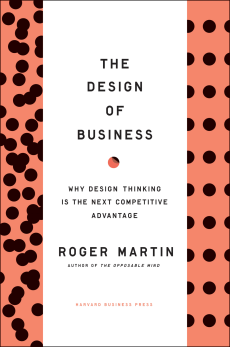
The Design of Business: Why Design Thinking Is the Next Competitive Advantage
Roger L. Martin
256 pages, Harvard Business School Press, 2009
Many books and articles support the view that an organization must choose between creating value through innovation and creating value by building scale and wringing out cost. The thinking styles and capabilities required for success appear to be diametrically opposed. Innovators are right-brained people who rely heavily on their intuition, whereas the leaders of large, efficiency-oriented organizations achieve results through rigorous, continuously repeated analytical processes and reject decisions based on instinct and judgment.
In The Design of Business, Roger Martin contends that organizations can balance intuitive originality and analytic mastery in a dynamic interplay that he calls design thinking. This approach is necessary, according to Martin, to maintain long-term competitive advantage.
As the dean of the Rotman School of Management at the University of Toronto and an advisor to many CEOs, Martin has worked with and studied a wide range of organizations. He has come to embrace the design thinking approach after seeing its powerful impact in a diverse array of companies. The vivid articulation of these company stories, paired with some very useful conceptual frameworks, makes The Design of Business both compelling and actionable.
Martin anchors many of his concepts in a framework depicting the way knowledge advances. He calls this the knowledge funnel. Knowledge begins with the contemplation of a mystery, advances through the development of a heuristic based on experience, and finally gets refined into an algorithm that can be reduced to software. Movement through the knowledge funnel is necessary to scale up innovation, but to keep innovating, a firm must return to the mouth of the funnel.
As organizations move down the knowledge funnel, they tend to become driven by an analytical approach to management that is incompatible with exploration of new mysteries at the top of the funnel. This is the crux of the conflict between innovation and scale. Martin does not claim that it is easy to overcome this conflict, but he offers several examples of companies who have done just that. Although no cases from the nonprofit sector are included in the book, the ideas are equally applicable there.
P&G’s journey to become a design thinking organization provides a strong counterpoint to the view that innovation and scale cannot coexist. In 2000, the company’s stock price was declining precipitously, revenue growth had ground to a near halt, acquisitions were slowing down, and most of its biggest brands were losing market share. For the first time in the company’s 165-year history, the board fired the CEO. In June 2000, the board promoted A.G. Lafley as the new CEO. Lafley quickly recognized that G’s innovation engine was stalling.
To reverse the slide, P&G had to become more innovative, but the expense side of the value equation also had to be addressed. Lafley set about to tackle innovation and efficiency simultaneously by turning P&G into a design organization. In 2001, he appointed Claudia Kotchka as the company’s first-ever vice president for design strategy and innovation, with a mandate to build P&G’s design capability and act as the company’s champion of design thinking. Martin provides deep insight into how Kotchka and Lafley tackled this transformation.
The results speak for themselves. According to P&G’s recent annual report, virtually all organic sales growth over the past nine years came from new brands and new or improved products. P&G has also established significant scale advantage at all levels. These achievements have been accompanied by strong financial results.
Unlike P&G, RIM, the company that invented the BlackBerry, was structured as a design thinking company from the outset. Founded in 1984, this fast-paced, high-tech pioneer manages the tension between innovation and scale through a co-CEO model. Founder and President Mike Lazaridis is a design visionary, and co-CEO Jim Balsillie leads the business side. This duo has been effective at actively pushing knowledge down the funnel while continuously returning to the mouth of the funnel, trying to discover new things or see things in a new way. The speed of RIM’s movement through the funnel has resulted in competitive advantage in both cost and innovation.
Martin provides evidence that although it is difficult, it is possible to balance exploration and exploitation. The well-developed cases provide enough specificity to serve as a rough road map for leaders interested in pursuing the design thinking path. Martin also dives into the organizational issues of structure, process, and cultural norms, areas that tend to get in the way of design thinking and need to be addressed.
As someone who wears the scars of many battles fought for innovation during 22 years at Hewlett-Packard, a company that succumbed to the natural bias toward scale, I’d give most companies poor odds of achieving the balance Martin espouses, but they will be better for trying.
Debra Dunn is an associate consulting professor at the Hasso Plattner Institute of Design at Stanford University and an advisor to business and social entrepreneurs. She previously grappled with the tension between innovation and scale from every angle as a senior executive at Hewlett-Packard.

